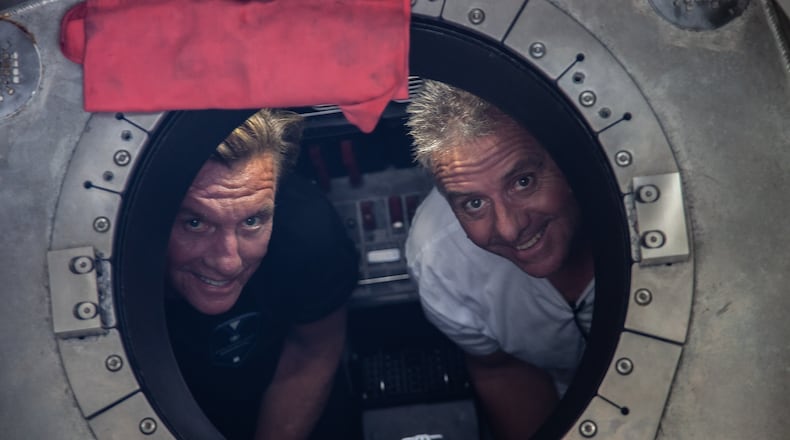It was halftime of the extraordinary adventure game he’s in, one that just took him to the deepest depths of the ocean and, in less than 10 months, is scheduled to launch him into space as he pilots the first-ever all private mission to the International Space Station.
Only two other people in history have gone to such extremes in inner and outer space and none has done so in such a short time span.
Two weeks ago Connor – CEO of his real estate investment firm, philanthropist, sports adventurist and ardent backer of UD basketball – made three deep dives in five days at the Mariana Trench in the Western Pacific Ocean, some 200 miles from Guam.
Sitting shoulder to shoulder with Patrick Lahey in a 5 ½ by 5-foot submersible called the DSV Limiting Factor, he explored the deepest ocean points in the world. The first dive was to the Challenger Deep, 35,856 feet below sea level. Then came a trip to Sirena Deep at 35,150 feet and a third dive was made along an extinct volcano, just over 25,000 feet underwater.
Lahey is the owner of Triton Submarines, which made the submersible. He piloted the mission though he did turn the controls over to Connor – an experienced pilot of multiple aircraft – for extended periods on two dives as he collected data.
“The trip was phenomenal,” Connor said. “It’s a different world down there.”
He said it takes 4 ½ hours just to get down to the ocean floor in Challenger Deep.
“Once you get below 600 feet, it’s pitch black,” he said. “So for 4 hours and 20 minutes of the 4 ½ hour descent you’re in darkness.”
He said while there’s “a good lighting system” on the mini sub, visibility is still limited. But throughout the dives they were in communication with the mothership up above and especially with the mission’s chief scientist Dr. Alan Jamieson.
While Lahey – who has worked or been a part of 60 different subs and was involved in the design, engineering and building of this one – has made numerous deep ocean dives, he and Connor made some previously unseen discoveries while also taking hours of video and collecting samples of everything from bacterial mats to deep sea anemones.
Connor was most impressed by the yet unnamed extinct volcano – with its sheer 1,000 foot walls and different color formations.
According to Dr. Jamieson, Connor and Lahey became the first humans ever to view the translucent Mariana snailfish, the deepest living species of fish, in its natural habitat at over 26,000 feet below sea level.
At that depth the pressure is over 1,000 times greater than the standard atmospheric pressure of water and would crush almost everything. Yet these fish actually thrive in the harshest place on earth.
Connor and Lahey took video of the fish which was first located seven years ago and was photographed by an unmanned device operated by a Japanese group in 2017.
“Capturing the Mariana snailfish on video is scientific gold,” Jamieson said in a statement praising Connor’s and Lahey’s efforts. “They also brought back hours of astonishing footage and samples that will help us better understand the geologic and biologic make-up the hadal zone (the ocean’s deepest regions, beginning at 20,000 feet.)”
Credit: HANDOUT
Credit: HANDOUT
Connor hopes their dives “actually make a difference.”
He said that could be “hopefully on the scientific or the medical front, but also maybe just for a person hearing about this.
“Maybe they’ll say ‘Well, that guy was just an average, normal guy from Dayton, Ohio, who ended up doing some extraordinary things. So why can’t I do that?’
“And I completely agree.
“People face all kinds of challenges in life. And the first step is to engage and say ‘I’ll venture forward. I’ll take the initiative. I’ll take the first step. You’ve got be willing to go outside your comfort zone. You never know what you can and can’t do unless you try, right?
“That’s true in anything – sports, business, non-profits. I think too many people underestimate what they’re capable of doing.”
In contrast, he’s always pushed the envelope – whether it’s been in racing, rafting, mountain climbing, aerial acrobatics competitions – but never like he is in this 10-month span.
And the trip to the space station is the most challenging.
In June, he and the three other crew members begin training for a week a month at the SpaceX headquarters in California. Eventually they also will train in Houston, where Axiom Space, the private aerospace company responsible for the mission, is headquartered.
Full-time training starts in September and will continue to the launch, which is scheduled for Feb. 1, 2022 at Cape Canaveral, Fla. Some training also will be done there and additional preparations will take place in Russia, Germany and Japan.
Even with the extensive training, Connor said he hopes he’ll be able to come home for a few weekends to catch some early UD basketball games. He spearheaded the recent $72 million upgrade of UD Arena and when we talked the other day, a good chunk of the conversation was about the Flyers roster and their prospects for the upcoming season.
But once UD gets into the heart of its Atlantic 10 schedule, he will be fully immersed in final preparations for the 10-day mission which will include eight days on the ISS.
With the ocean dives now completed, Connor said: “Right now all eyes and focus are on the next mission. I think it’s going to be something really special.
“And, if nothing else, we should have some great stories to tell afterward.”
About the Author

